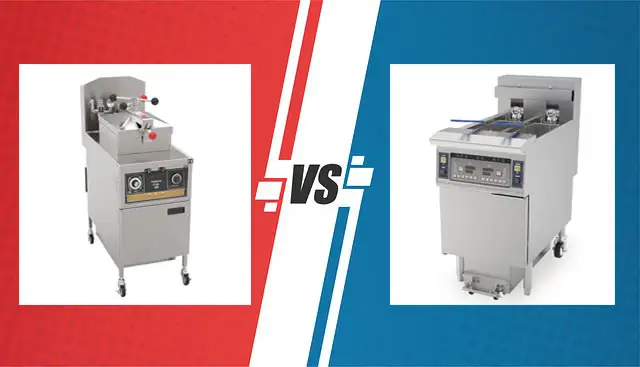Address
1F, Building 13, No.1881, Zhengbo Road, Lin-gang Special Area, China (Shanghai) Pilot Free Trade Zone
Work Hours
Monday to Friday: 8AM - 5PM
Address
1F, Building 13, No.1881, Zhengbo Road, Lin-gang Special Area, China (Shanghai) Pilot Free Trade Zone
Work Hours
Monday to Friday: 8AM - 5PM

People love fried foods is undeniable, ranging from crispy chicken and fish to golden-brown potatoes, onions, and a multitude of other delights.
While it’s no secret that fried foods are a cherished indulgence, what many may not realize is that there are diverse methods employed in restaurants to prepare these beloved dishes.
The two most prevalent techniques, open frying and pressure frying, each have their own distinct approaches to delivering delicious, crispy results.
We’ll explore the differences between open fryers and pressure fryers and discuss why pressure fryers can often be the better choice.
Open fryers, also known as deep fryers, have been a staple in the culinary world since their invention about 200 years ago.
This traditional method involves submerging pieces of food into a large vat of cooking oil. In many open fryers, a basket is employed to lower the food into the hot oil, a familiar setup in quick-service restaurants that frequently churn out batches of French fries.
In contrast, pressure fryers are a relatively more recent invention, dating back to the 1950s. These fryers cook food under pressure within a sealed cooking chamber, typically maintained at around 12 pounds per square inch (psi).

Pressure frying excels in preserving the flavors and juices of the food. It seals in seasonings and natural juices, resulting in a more succulent, tender, and flavorful end product. Pressure fryers also tend to cook food more consistently.
The design of the pressure frying equipment plays a pivotal role in the quality of the finished product. For instance, utilizing a round cooking well ensures more uniform heat distribution by eliminating cold spots in the corners. The result is consistently well-cooked chicken, batch after batch.
One of the most significant advantages of using a pressure fryer is the reduction in cooking time. For example, while it might take up to 18 minutes to cook eight pieces of bone-in chicken in an open fryer, a pressure fryer can do the same job in just up to 12 minutes.
This time-saving feature translates to higher output over the course of a day and happier customers who don’t have to wait as long for their orders.
Pressure fryers allow food to be cooked at lower temperatures. This means that the cooking oil remains stable for a more extended period, reducing both the cost of the oil itself and the labor required to change it since it doesn’t need frequent replacement.
While open fryers tend to produce a crunchier product due to the longer cooking times, if your priority is taste, juiciness, consistency, and efficiency, a pressure fryer is the way to go.
From a cost perspective, while the initial purchase price of a pressure fryer may be slightly higher, it often offers distinct advantages in terms of operating costs.
Pressure fryers cook faster and at lower temperatures, resulting in significant savings on cooking oil, energy consumption, and labor costs over time.
Moreover, consider the durability and ease of maintenance when selecting a pressure fryer, as a well-maintained fryer can prolong its lifespan, reducing the need for costly repairs and labor expenses.
When choosing between open fryers and pressure fryers, it’s essential to consider the specific needs of your restaurant, the quality of the finished product, and the long-term cost implications.
While open fryers have their merits, pressure fryers often emerge as the superior choice for those seeking efficient, high-quality fried dishes.